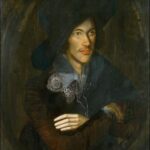Stanza 1
Personification is used in line 1, where the storm is ‘howling’ (crying). It is not the first time that it has happened, which tells us that storms frequent the area. The baby sleeps, wrapped warmly, in his cradle. The wind outside, which starts on the Atlantic Ocean, is strong enough to level roofs and haystacks. The only things between the wind and the house are Gregory’s Wood and a bare hill. The poet has spent an hour walking and praying. He is worried. His mind is as stormy as the weather.
Stanza 2
Personification is used again in line 10 where the wind is described as screaming. The poet has walked on the tower, under the arches of the bridge and under the elms next to the flooded streams. He imagines in his mind that the future is upon him and his baby daughter all grown up. He speaks of dancing and a frenzied drum, which indicates his concerns for his child when she is a woman. The antithesis in line 16 shows his concerns of the vices of evil upon good.
Stanza 3
For his daughter he wishes a subtle beauty that does not attract too much attention. He doesn’t want her to see beauty as a means to an end. If she finds herself very beautiful she will become vain and lose her inner beauty: kindness and the ability to choose what is right. She will also never be liked or loved and end up having no friendships.
Stanza 4
Helen was a woman who found life dull in a relationship. She later had many problems with a foolish man. The Queen made an unwise choice, choosing a bandy-legged man who worked with horses’ shoes. A wise choice would have been to choose the best that is offered. The Horn of Plenty is represented in art as overflowing with flowers, fruit and corn. This shows that there is a wide variety of men to choose from, but fine women cannot choose wisely.
Stanza 5
He wants to teach his daughter courtesy. The poet believes that falling in love because of beauty is not worthy. Love is earned by those who are less beautiful. And once they find love their partners remain faithful. Many foolish men rove around beautiful women and have mistaken their feelings for love.
Stanza 6
He wants his daughter to grow into a beautiful woman, one that blends in well with the community. She is compared to a hidden tree (simile). Her thoughts must be pure and peaceful, like that of a common little linnet – a brown songbird. Like the bird she mustn’t want more than what is natural and normal. The linnet does not chase after pleasure and it doesn’t find pleasure in quarreling. He wants his daughter to settle well in one place, like a green laurel.
Stanza 7
The poet fell in love with the wrong kind of women. This made his mind dry up. He thinks the most evil thing is being filled with hate, and believes if there is no hatred in a person’s mind, that person will be fortunate and safe. He compares his baby girl to a little lintel (a bird). Just as the little bird stays on a leaf during strong winds, his daughter will remain safe if she is not subjected to hate.
Stanza 8
He doesn’t want his daughter to become opinionated. He thinks intellectual hatred is the worst. A direct contrast is made between an opinionated mind and a quiet nature. He also makes a contrast of the full horn and empty bellows. The woman he once knew exchanged the horn of plenty and all good things for old bellows full of angry wind. Her choices in life made her bitter when old.
Stanza 9
A soul becomes innocent when all anger and hatred has been driven away. Without hatred a woman learns to be happy, soothed and to respect herself. And even when everyone around her scowls and the storms beat on, she will still be happy.
Stanza 10
The poet wants his daughter to marry. Her bridegroom must give her a house with custom and ceremony. Arrogance and hatred are in public places and everyday life, but at home there should be normality and order (custom – usual practice), where things are done at the proper time (ceremony – doing proper things at a certain time). In other words, he wants his daughter to have a normal, happy life. The two metaphors used in this stanza are the horn and the laurel tree. The horn is ceremony and the laurel tree, custom.




